Dog clothes, pup apparel, canine costumes, and pooch gear are a booming market.
The American Pet Products Association tells Whole Dog Journal that nearly one in four dog parents have clothes for their dog, and that number has increased 35% in the last few years.
Veterinarians say dog clothes can serve practical purposes, and industry experts say apparel and gear designed for dogs can help keep them safe and even enrich the bond between you and your pooch.
Whole Dog Journal is reader-supported. If you purchase through links on our site we may earn a commission. Whole Dog Journal does not accept money for its food and product reviews.
Do Dogs Need Clothes?
While a dressed-up pup in a costume can look cute for a social media post or annual holiday card, many dog clothes serve essential purposes.
Sun and Heat Protective Dog Clothes
There are entire clothing lines of vests, suits, visors, hats, and even nose protectors designed to shield dogs from the sun’s harmful rays, but not all dogs need these kinds of safeguards.
“The average, darker pigmented-haired dog with a dark colored nose does not need that protection,” says veterinarian Mitzi Clark, an assistant clinical professor of dermatology at Cornell University College of Veterinary Medicine.
But hairless breeds like the Chinese Crested or dogs missing fur due to medical problems may be at higher risk of developing skin cancer—as their hair helps protect their skin from the sun’s rays—and may benefit from protective clothing.\
“The white pit bull who has a pink nose, sparse hair on their belly, who’s going to sunbathe, or the dog that doesn’t have hair, because they’re a hairless breed—maybe, especially if you live in Arizona,” Dr. Clark says.
“If those dogs are going to spend time outside and if they’re not going to have sunscreen, clothing that has SPF protection could be useful.”
Some of the sun shield clothing is also designed to keep a dog’s body temperature lower in hot weather; they’re typically called cooling suits or vests.
“That can be very helpful for brachycephalic dogs,” says extension veterinarian Aly Cohen from the Cornell University College of Veterinary Medicine.
Snow and Cold Protective Dog Clothes
When the temperature drops from sunny summer to snowy winter, it’s time for some dogs to sport fleeces, coats, snow gear, and booties. Should your pup bundle up?
“Some older dogs do need clothes for warmth, because they’ll start to lose muscle mass or could have an underlying health condition that makes it harder for them to generate and maintain warmth,” Dr. Cohen says. “It’s like the 90-year-old grandma who’s wearing her sweater outside in the summer.”
Dogs with little to no hair, or a pooch that appears to be unhappy in the cold, may need protection from the chilly elements.
“Shivering is a dead giveaway,” Dr. Cohen says. “If they’re trying to go back inside right away, or they’re reluctant to walk, or vocalizing outside with whining or barking for no other obvious reason, those may be the telltale signs that they’re just uncomfortable with the temperature.”
Dog Clothes to Improve Mental and Physical Health
Some pet parents swear by weighted, calming vests, and ThunderShirts, which are supposed to take the edge off their dog’s anxiety. The clothing wraps around a dog like a coat while applying pressure to their body. The theory is that the vest-like shirts have a calming effect, like a parent swaddling a baby.
There are also “spay suits” or recovery clothing, which can be a reasonable option to the dreaded “cone of shame” after surgery. These pajama-like outfits cover the incision area and sutures so your dog can’t lick or scratch them. (If a dog is very intent on getting at their stitches, the cone of shame may be necessary.)
With any dog clothes, always supervise your pooch so they don’t chew or ingest any material, and of course, ensure they’re comfortable.
Why Have Dog Clothes Gotten So Popular?
Some industry experts attribute the massive growth in the dog clothing market to the exploding number of pet owners who are treating their dogs like family.
“That just enriches both the human and the dog’s life,” says Peter Kearns, head of product at Ruffwear, which specializes in making dog performance gear, including jackets, raincoats, and snowsuits.
Tapping into that human-dog bond, Ruffwear’s product lines, popularity, and business have expanded exponentially in the last three decades. The company is now a global brand sold in 52 countries.
“Our growth has come purely from our curiosity about how else can we create a connection between dogs and their human companions,” Kearns says. “We really exist to be able to enable adventure, and we want to bring the connection that dogs and humans have together to the outdoors, and we want to do that in a way that empowers both the dog and the human.”
The company also makes specialized gear that goes beyond protecting your dog from the rain or snow, tapping into the massive number of people bringing their dog on outings, saying, “I’m so glad we included our dog…” instead of, “Our dog would have really loved this…”
“We have products that allow people to get on stand-up boards with their dogs for the first time,” Kearns says. “If you have a small dog, an elderly dog, or maybe a tripod who has a hard time going many miles on a hiking trail, we have a pack that you can carry that dog with. We have boots that enable them to go into areas where maybe it’s obsidian and very sharp rock or hot sand.”
Of course, the key to making sure dog clothes, outerwear, and gear are enjoyable for your pup is to ensure you have the right dog measurements for a perfect fit.
How To Measure a Dog for Clothes
When you order dog clothes, there’s always the dreaded moment where you have to get out the tape measure and get your dog’s measurements. Some take off running, others think the measuring device is a toy, or they won’t stand still.
It’s essential to pay close attention to a company’s clothing size guide when you order. Different retailers’ sizing may vary. A medium in one brand may be totally different than another.
“From a fit standpoint, it’s going to be dependent on the dog,” Kearns says–and shares some dog measuring tricks of the trade.
How To Measure a Dog’s Girth
Kearns says accurately measuring your pup’s girth is key to getting a good fit. Be sure your dog is standing on a completely flat and level surface.
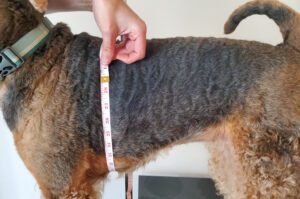
“Measure around the widest part of your dog,” Kearns says. “Generally speaking, that’s right behind the armpit of the dog. It’s going to be a little bit different on each dog, but kind of find the broadest or the widest circumference, and that’s where you want to measure–that’s your starting point for the measurement.”
Each product will have some variation in the fit, and the dog’s fur type is also a factor.
“If you have a dog with longer, fluffier hair, tighten it (the tape measure) up a little bit so that you can kind of compress that fur a little bit; know that the true fit of the product is going to be, against the dog’s body, not kind of out where the fur might come to,” Kearns says.
How To Measure a Dog’s Height
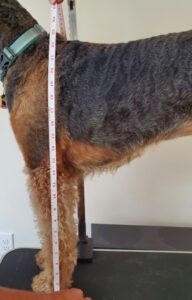
To measure a dog’s height, keep them on that flat, level surface and as still as possible. “Give them a little peanut butter and they’ll stay in place,” Kearns says. “That’s going to be the trick to get a good measurement for just about anything.”
Locate the highest point where the dog’s neck aligns with their shoulder blades. Use a tape measure or a yardstick to measure the distance between that point and the ground where they’re standing.
How To Measure a Dog’s Length
Since dogs come in all shapes and sizes, you may want to measure their length to see how the clothing will fit on their body.
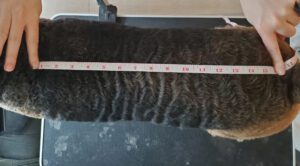
“Measure from the base of the neck to the base of the tail to understand where that dog jacket is going to land on your dog,” Kearns says. “If you want to size up a little bit, because you want it to go a little bit longer on the dog’s back, you can do that. If you want to size down a little bit, then you can shorten up a little. So always start with the girth measurement and then use those other measurements as kind of a reference point for how it will look on your dog.”
Ruffwear has videos on its website that demonstrate how to get a dog’s measurements successfully.
And once your dog’s new threads arrive, remember that you may be thrilled to try out their new gear, but your pooch may not be.
“Go slowly,” Dr. Cohen says. “Use treats to encourage them to have a positive experience.”


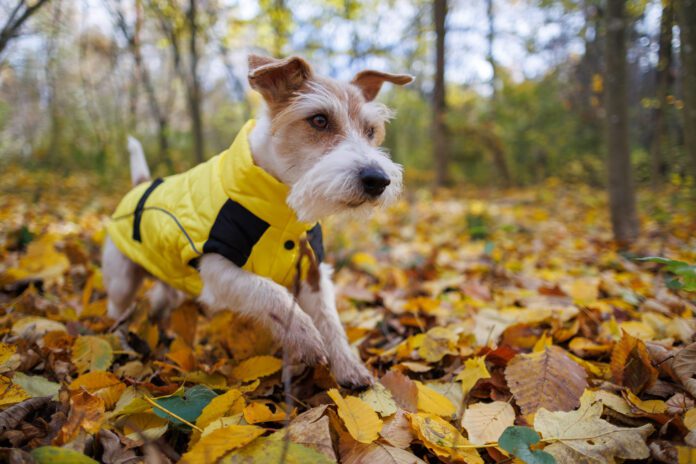


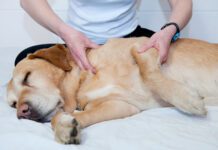
Where can I find that yellow jacket that is in the illustration?